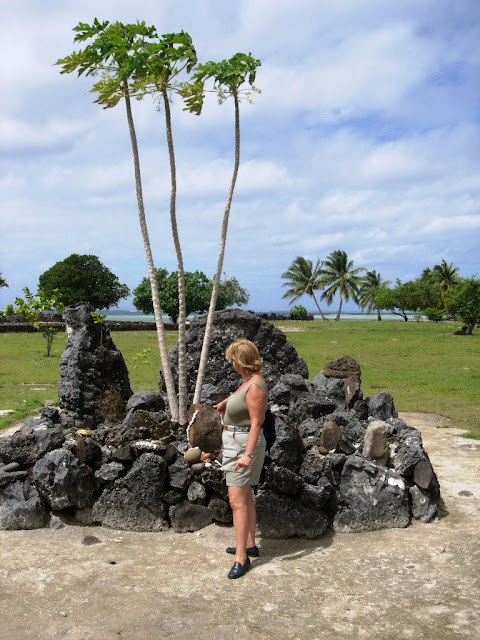Our next destination was Raiatea. The island, shaped like an isosceles triangle with a base of 14 kms and a height of 20 kms, has an area of 238 square kilometres and a population of about eleven thousand persons. That makes it the fourth largest in French Polynesia, and the second largest in the Society Islands in terms of area. Raiatea is located in the southern part of the Leeward Islands and is situated approximately 120 miles northwest of Tahiti, directly between Tahiti and Bora Bora. The island, with its tallest point - Mt. Tefatoaiti - at an altitude of 1,017 meters, is an old former volcanic mass, the last lava having flowed some 2.5 million years ago. It has six bays favourable for populations to settle, and its main village is Uturoa. Raiatea and Tahiti are the only islands that have a port allowing large cruise ships to dock.
Raiatea has the reputation of being the cradle of Polynesian civilizations. In ancient times, the island was known as Havai'i fanau'ra fenua, which means «Havai'i, the cradle». Raiatea also played the role of a religious centre beginning in the sixteenth century. The large Taputapuatea marae, dedicated to Oro - the Polynesian god of war - was built at Opoa in the south-eastern part of the island, and in ancient times received the visit of many priests from Polynesian islands throughout the Pacific. Many of these stone structures, including the Tainuu and Taputapuatea international marae, have been restored.
There is one traditional flood story regarding Raiatea, that makes an analogy with the biblical story of Noah, though this version was widespread before the arrival of missionaries. Ruahatu, god of the sea in Polynesian mythology, had a man's body with the tail of a swordfish. This god of the ocean, disturbed by a fisherman in his coral home, decided to cause the flooding of all the islands. The only survivors were the fisherman, his friend, his wife and child and some animals that went to the Toa-Marama islet, the preferred place of the god of the sea. The sea rumbled, rising over the land and sweeping away everything, trees, houses, birds, animals and fish, as well as all humans who had not believed the fisherman's message. But the family was saved, along with a dog, a pig and a couple of chickens...

"WINDY SEA - When we arrived at Raiatea by 6:30 A.M., the wind was blowing and the captain was unable to dock the ship. So we anchored at the lagoon, and came ashore, once again, with the tender..."

"RAIATEA AIRPORT - We had already landed on this runaway, when we were heading to the Taha'a Private Island"

"SAILING"



"PORTUGUESE PAVEMENT (Calçada Portuguesa). Actually, one of the charming hallmarks of Portugal's streets is their decorated pavements, with armillary spheres, caravels and vessels, crosses, stars, and animals. It all started in 1849 after the completion of the wave design known as «the wide sea» in Lisbon's Rossio Square, followed by the pavements of most of Lisbon's streets, the rest of the country, as well as in Brazil - the «wide sea» design seen in Rio de Janeiro's famous beaches – and even in Macau. New York's Central Park's tribute to John Lennon, and the New Jersey Performing Arts Centre also used this art form. Limestone is hewn by hand, and Portuguese pavement is part of the country's heritage and identity, continuing to decorate the streets and squares all over Portugal. Being usually used in sidewalks, it is in plazas and atriums this art finds its deepest expression. Some Portuguese craftsmen did come to Raiatea to create the pavement that can be seen at Raiatea’s port!"


"PORT GARDEN - Nice flowers and trees"

"BELVEDERE - Going up from the Bay of Faaroa on the road towards the west coast, we reach a Belvedere that offers a beautiful panorama with the Bay in the background, and the Faaroa river, which is quite magical and holds much fascinating Tahitian historical lore"

"PUOHINE, with a population of just 151 people, is one of the sections of the Taputapuatea district"


"VANILLA PLANTATION - Polynesian Vanilla has the worldwide reputation as being the best that can be found. Raiatea, Taha'a, and nearby Huahine grow almost all of French Polynesia's vanilla crop, with Taha'a accounting for roughly 80%"

"VANILLA FARM SHOP"

"FLOWERS"






"TAPUTAPUATEA ARCHAEOLOGICAL SITE is the oldest and most famous of all the ancient outdoor Polynesian temples of worship, where the great international marae is found. When the first Europeans arrived in Polynesia, this marae was the most sacred of the marae found in the Society Islands, so famous that all the Taputapuatea marae devoted to the god Oro on the islands of Tahiti and Moorea got their foundation stones from this marae on Raiatea. Located along the shore of Opoa, Taputapuatea regroups several marae. The most imposing structure was built in the early part of the seventeenth century in honour of the god Oro, and in the interior of this marae there is an impressive erected stone marking the investiture place for the «ari’i», the Polynesian Kings. According to tradition on Raiatea, the royal ancestry of the Pomare family is linked to this marae, which allowed members of that family to reach the highest royal ranking in Tahiti. When the Oro (god of war) cult developed, this marae was where big ceremonies requiring many human sacrifices were held"

"BY THE THREE TREES"

"BY THE SEA"




"PALM TREES"


"BLUES: SKY, SEA, LAGOON!"

"GREEN ISLET, BLUE HUAHINE - Raiatea has no beaches, so locals and tourists head out to the many of the lagoon motus!"
































6 comments:
Spectacular images, as always!
Its such a treat to visit your blog everyday :-)
Some wonderful collection of shots!
Awesome blog!! Thanks for dropping by...since I am a travel bug myself, really enjoying the posts here!
Thanks everybody for dropping by... I loved your comments!
loved all your photos,i woould love 2 go there 1 day,my great nan was part of the royal family,please do you no more about them?
Anonymous,
Sorry; no further knowledge about the royal family...
Post a Comment